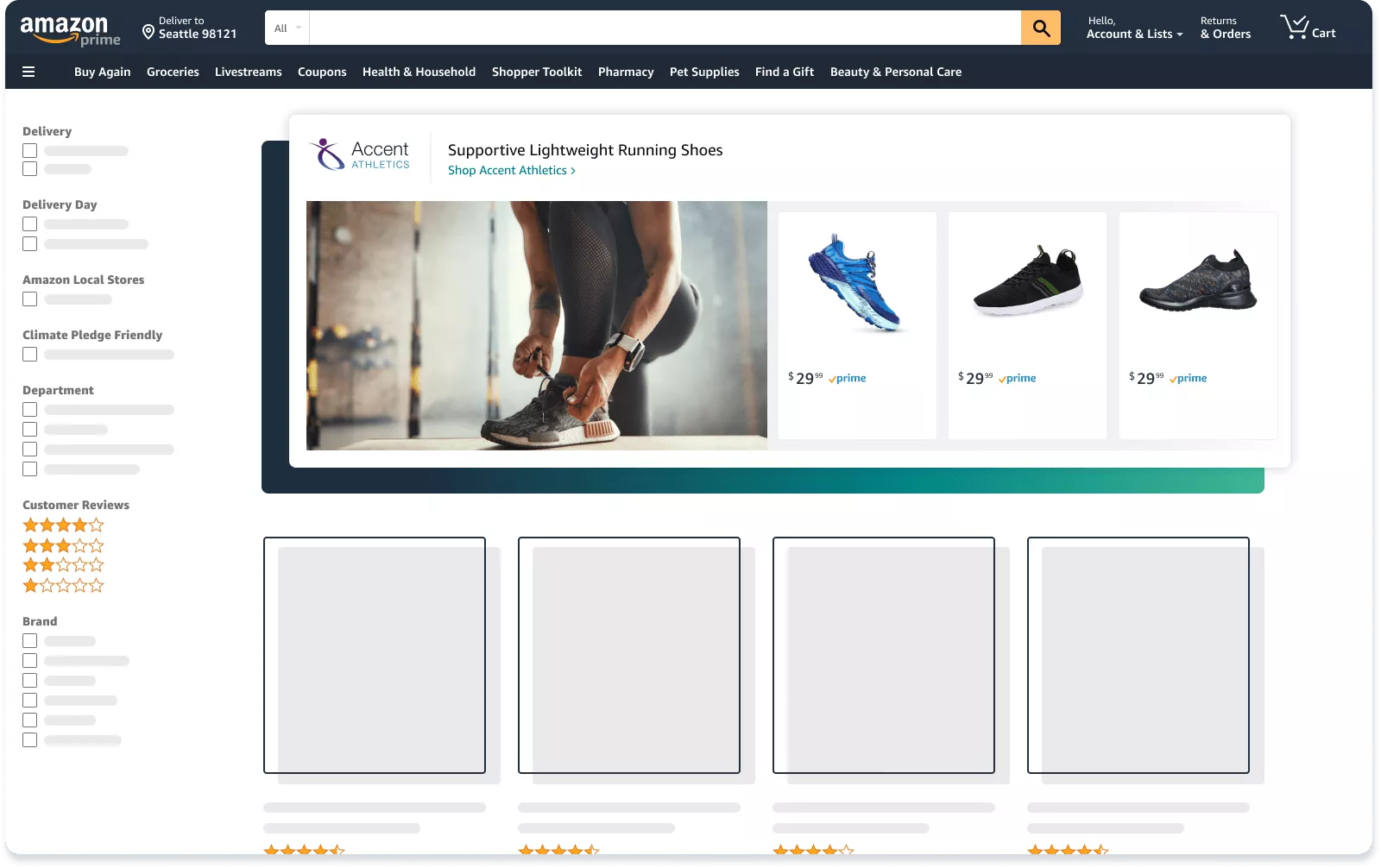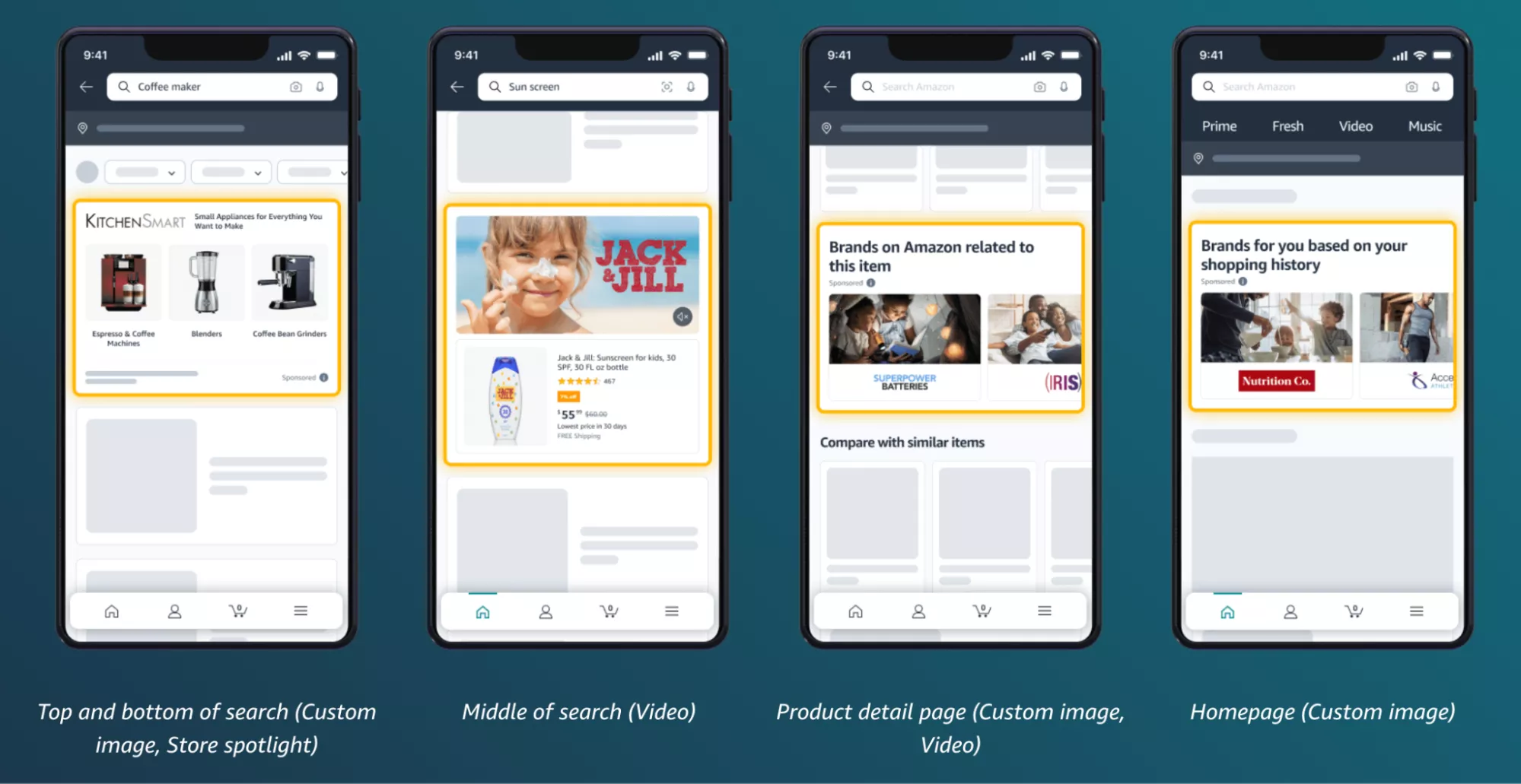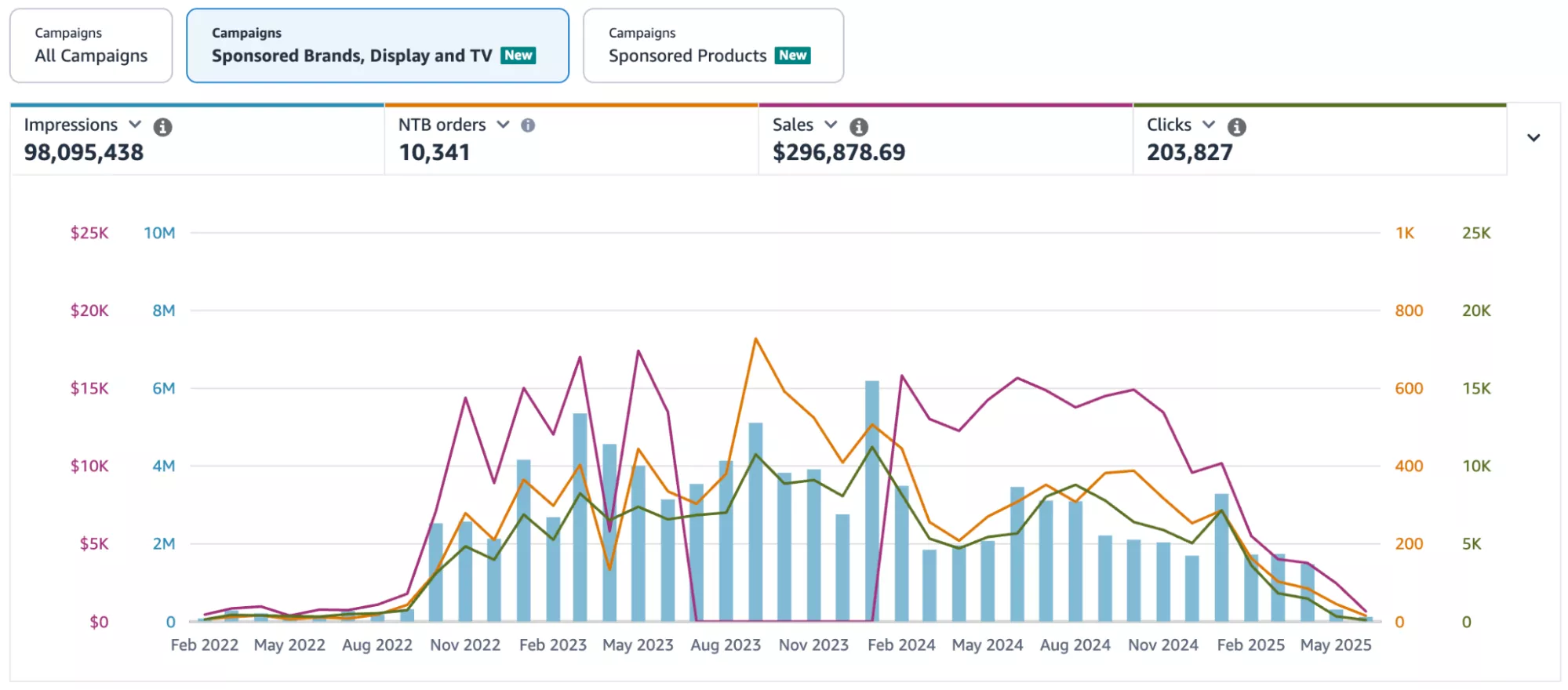Amazon Sponsored Brands Strategy: A Step-by-Step Guide to Stop Competing on Price
Look, I get it. You’re tired of playing limbo with your prices – how low can you go before your profit margins disappear entirely? Here’s the thing: Amazon Sponsored Brands advertising isn't just another way to throw money at Amazon (though they certainly won’t complain). It’s your ticket off the price-cutting hamster wheel and into the land of actual brand recognition.
While everyone else is slashing prices like they’re at a Black Friday sale, smart sellers are using Sponsored Brand ads to build something that discount warriors can’t touch: genuine brand awareness. Because here’s a revolutionary thought – customers will pay more for brands they actually know and trust.
What Are Amazon Sponsored Brands?
Amazon Sponsored Brands is Amazon’s premium pay-per-click (PPC) advertising instrument designed specifically for, well, brands. These aren’t your run-of-the-mill product ads that get lost in the shuffle. These puppies show up at the top of Amazon search results like they own the place – because in Amazon’s world, they kind of do.
Think of Sponsored Brands on Amazon as your brand’s VIP pass to the front of the line. While regular product ads are fighting for scraps at the bottom of the page, your brand gets prime real estate that screams “we’re legit” to potential customers scrolling through their shopping lists.
What Does Amazon Sponsored Brands Include?
Amazon advertising Sponsored Brands come in three delicious flavors:
Product Collection Ads showcase three or more of your products in a neat little row, perfect for showing off your range without looking desperate. These ads are fantastic for cross-selling and upselling – because why sell one item when you can sell three?
Store Spotlight Ads are all about brand storytelling. These focus on your brand itself and show categories of goods, making you look less like a random seller and more like an actual business worth remembering.
Sponsored Brand Video Ads let you show off with short, autoplay videos that demonstrate your product in action. Fair warning: These are pricey, so save them for your absolute best performers.
How Does Amazon Sponsored Brands Work?
The mechanics are refreshingly straightforward. You set your budget, choose your targeting options, create your ads, and Amazon does the heavy lifting of placing them where people will actually see them. The beauty is in the placement – top, middle and bottom of search result pages where your target audience is already hunting for solutions.
But here’s where it gets interesting: Unlike regular product ads that just scream “buy me now,” Sponsored Brand ads work on building relationships. They’re designed to drive traffic to your brand storefront, encourage exploration of your full product line and create that magical thing called brand recognition.
Who Needs Amazon Sponsored Brands?
Scenario 1: The Price War Survivor
You’re locked in a never-ending race to the bottom with competitors who keep slashing prices like there’s no tomorrow. Every time you think you’ve found a sustainable price point, someone undercuts you by another dollar. Your conversion rates are solid, but your profit margins have shrunk to practically nothing – you’re making pennies on products that used to fund your business growth.
The Solution: Sponsored Brand ads let you compete on value instead of price. When customers see your brand consistently at the top of search results, you’re not just another random seller – you’re an established brand worth paying a premium for.
Scenario 2: The Invisible Achiever
Your products are fantastic, your reviews are stellar, but you’re buried on page three of search results where dreams go to die. You’re getting organic sales, but they’re trickling in slower than Amazon’s algorithm updates.
The Solution: Brand ads give you immediate visibility boost and help you leapfrog the competition. Plus, the increased traffic helps improve your organic rankings – it’s like compound interest, but for visibility.
Scenario 3: The One-Trick Pony
You’ve got one bestselling product, but customers aren’t discovering your other offerings. Your average order value is stagnant, and you’re missing out on obvious upselling opportunities.
The Solution: Product collection ads showcase your full range, encouraging customers to explore beyond their initial search. Store Spotlight Ads can drive traffic to your brand storefront where the magic of complementary products can work its charm.
Eligibility and Requirements: The Velvet Rope Policy
Before you start dreaming of brand domination, there are a few hoops to jump through. Amazon isn’t letting just anyone into their Sponsored Brands club.
Amazon Brand Registry is non-negotiable. This isn’t a suggestion – it’s the price of admission. You need to have your brand registered and approved before Amazon will even consider your application for Sponsored Brand ads.
You need a Professional Seller account. If you’re still on an individual plan, upgrade now, or don’t bother with Sponsored Brands.
Your account health metrics need to be squeaky clean. Amazon doesn’t want brands with poor performance standards representing their platform at the top of search results. Makes sense – they’ve got a reputation to maintain.
You’ll also need at least three subcategories of products for certain ad types. This requirement actually makes strategic sense because it increases engagement across all your categories and gives customers more reasons to stick around your brand ecosystem.
The good news? Whether you’re running a garage startup or managing a massive enterprise, Sponsored Brand Ads work at any scale. The key isn’t your size – it’s how strategically you use them to boost visibility and drive actual sales.
Setting Up Your Sponsored Brands Campaign: Step-by-Step
Step 1: Register and Access Campaign Creation
First, register for sponsored ads if you haven’t already. Once you’re signed in, click “Create campaign” and select Sponsored Brands. Give your campaign a strategic name that helps you track performance later.
Step 2: Define Your Campaign Goal
Choose the campaign goal that aligns with your business objective. Don’t just pick randomly – your goal determines how Amazon optimizes your campaign and what success looks like.
Step 3: Select Your Ad Format Strategically
Amazon offers multiple formats, but choose based on your specific needs. Product collection ads work best for showcasing variety, Store Spotlight excels at brand building, and video ads should be reserved for top performers. If you need video help, use Amazon’s video builder templates.
Step 4: Choose Your Landing Page Destination
Decide whether to drive traffic to your Brand Store (better for brand awareness) or directly to a product detail page (better for immediate conversions). This choice impacts your entire funnel strategy.
Step 5: Define Your Targeting and Bidding Strategy
This is where precision matters. Select your targeting approach and set bids strategically – or use Amazon’s recommendations as a starting point. Focus on high-intent keywords rather than casting too wide a net.
Step 6: Upload High-Quality Creative
Your creative can be static images or video featuring your product or brand. Make sure whatever you upload actually showcases value – product features, benefits or problem-solving capabilities. Avoid generic stock photos.
Step 7: Submit and Wait for Review
Submit your ad for Amazon’s review process, which takes up to 72 hours. Use this time to prepare your next campaigns or optimize existing ones.
Best Practices That Actually Work
Craft Creative Ads That Stop the Scroll
Your Sponsored Brand ads are competing for attention with everything else on Amazon. Make them count. Use high-quality images that showcase your products’ selling points. Write headlines that speak to your target audience’s specific needs, not generic benefits that could apply to any product.
Highlight additional features and use animation when possible. Show the quality of your product compared to your competition. Successful sellers know that you’re not just selling a product – you’re selling an experience.
Keyword Optimization: Stop Guessing, Start Converting
Generic keywords are expensive and often ineffective. Focus on more specific terms that align with your actual products and target audience. Long-tail keywords often have better conversion rates and lower competition.
Use data-driven insights to continuously refine your keyword strategy. Monitor which terms are driving actual sales versus just expensive clicks.
Once your Sponsored Brands campaign is live, fine-tune it with precision. Use negative keywords to eliminate wasted spend, segment campaigns by intent (branded, competitor, category), and A/B test headlines to improve CTR. Adjust bids throughout the day with dayparting – boosting visibility during high-converting hours.
For deeper impact, combine Sponsored Brands with retargeting via Sponsored Display or DSP, and use Store Spotlight to cross-sell product lines. Track New-to-Brand (NTB) metrics to measure actual brand growth – not just clicks. These small adjustments create long-term performance gains without blowing up your budget.
|
Campaign Type |
Focus |
Bid Strategy |
|
Branded Search |
Protect your own brand |
Lower CPC, high ROI |
|
Competitor Targeting |
Capture brand-switchers |
Higher CPC, more risk |
|
Category Keywords |
Expand visibility |
Test mid-CPC range |
Keep high-margin and seasonal products in separate campaigns for agile budget shifts.
Leverage All Three Ad Formats
Don’t put all your eggs in one basket. Product ads deliver more immediate sales, but brand ads build long-term value. Use all three types strategically – they complement each other and create a comprehensive brand presence.
Sponsored Brands isn’t just about visibility – it’s about recognition. Expect CTRs of 0.35%–0.40 % and average ROAS between 2.5-4x. And don’t only run one format – combining Sponsored Products, Brands and Display drives +16 % uplift in total sales and +25 % ROAS versus Products alone.
Key Performance Metrics That Matter
Click Through Rates (CTR) expose the brutal truth: Are people interested or scrolling past? Low numbers mean your ads are boring or you’re showing them to the wrong crowd.
Advertising Cost of Sales (ACoS) determines whether you’re building a business or funding Bezos’ yacht collection. This metric separates profitable campaigns from expensive mistakes.
Return on Ad Spend (ROAS) gives you the bigger picture of campaign effectiveness. A good ROAS means your ads are actually contributing to your bottom line, not just generating activity.
Monitor impressions and reach to understand your brand’s visibility growth. These metrics help you track brand awareness improvements over time.
When Sponsored Brands Ads Are Worth It (Spoiler: When Done Right)
Sponsored Brand ads are only worth the investment when executed properly. They work best for brands that understand how to use emotion and storytelling. If your brand is eco-friendly, show how your packaging is better for the environment. If you’re premium quality, demonstrate why that matters to your customers.
The key is connecting with customers on values that transcend price. When customers understand why your brand matters to them personally, price becomes much less important in their decision-making process.
AI Integration for Smarter Campaign Management
Modern AI tools can optimize keywords, create compelling videos and images, analyze customer behavior trends, and estimate optimal budget allocation across campaigns. These tools automate budget spending decisions and simplify ad management, letting you focus on strategy instead of manual optimization.
AI can also help with A/B testing different creative elements to continuously improve ad performance. The technology is advancing rapidly, making sophisticated campaign management accessible to sellers of all sizes.
Products That Won’t Make the Cut
Amazon Sponsored Brands ads won’t work for generic products or items in restricted categories. Adult products, firearms, pharmaceuticals and other restricted categories are automatically excluded. You also can’t use brand ads for products that don’t have clear brand differentiation.
The platform is designed for legitimate brands with unique value propositions, not commodity sellers trying to game the system.
Reporting Tools and Analytics
Amazon Brand Analytics provides detailed insights into customer behavior and campaign performance. Third-party tools like Helium 10 and Seller Up offer additional analysis capabilities and competitive intelligence.
The Amazon Advertising Console is your central hub for campaign management and performance monitoring. Learn to use these tools effectively – data-driven decisions always outperform gut instincts.
If you're looking to go beyond basic ads and craft a long-term growth strategy, check out these related articles:
- What is Amazon Moments? A Comprehensive Guide to Rewards and Engagement Strategies – Learn how to boost customer loyalty and drive repeat purchases using Amazon’s unique reward system.
- How to Promote Products on Amazon – A deep dive into promotion tactics that go beyond PPC: including brand stores, external traffic, and product SEO.
Ready to scale your Amazon business the right way? Stop wasting money on campaigns that don’t convert. Partner with Amazon advertising specialists who know how to deliver results.
FAQ
What are Sponsored Brand ads?
Sponsored Brand ads are Amazon’s premium advertising format designed to promote entire brands rather than individual products. They appear at prime locations in search results and focus on building brand awareness and recognition.
Where do Amazon Sponsored ads appear?
Sponsored Brand ads show up in the prime real estate – top, middle and bottom of search results. Amazon puts them exactly where shoppers look when they’re ready to buy, not buried where nobody will see them.
What’s the difference between Amazon Sponsored Display and DSP?
Amazon DSP is the big leagues – you need a $30,000 monthly minimum just to play, but you get access to Amazon’s entire advertising universe, including external sites like Twitch. Sponsored Display is for the rest of us: Lower barriers to entry, focused on Amazon’s marketplace, and you won’t need to sell a kidney to get started.
Related Articles
Display Advertising Effectiveness Analysis: A Comprehensive Approach to Measuring Its Impact
In this article, I will explain why you shouldn’t underestimate display advertising and how to analyze its impact using Google Analytics 4
Generative Engine Optimization: What Businesses Get From Ranking in SearchGPT
Companies that master SearchGPT SEO and generative engine optimization will capture high-intent traffic from users seeking direct, authoritative answers
From Generic to Iconic: 100 Statistics on Amazon Marketing for Fashion Brands
While traditional fashion retailers were still figuring out e-commerce, one company quietly revolutionized how U.S. consumers shop for everything from workout gear to wedding dresses







